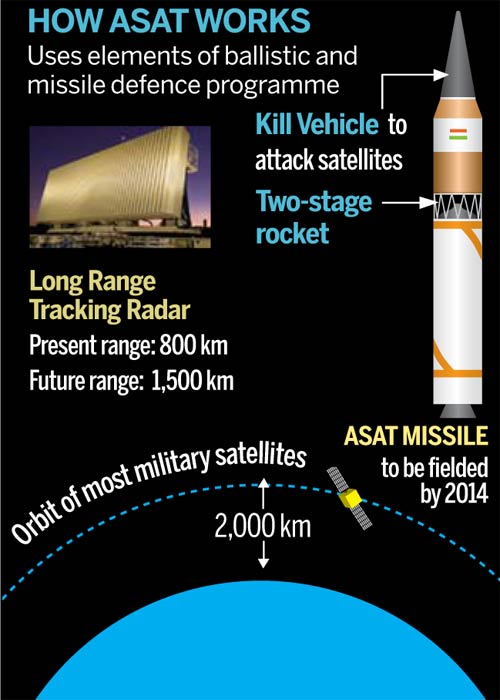rajkumar singh
New Member
- Joined
- Oct 20, 2014
- Messages
- 76
- Likes
- 91
India's varied missile capabilities are catching up to be at par with those of the US and China, as talks revolve around integrating the Agni-III ballistic missile with a satellite kill vehicle. According to DRDO Chief V K Saraswat, India is considering the feasibility of developing an anti-satellite missile which will lend a superior edge to India's missile power. -It would involve the development of lasers and an exo-atmospheric kill vehicle.
During a speech regarding DRDO's upcoming challenges and defence projects, DRDO Chief Saraswat touched upon the crucial issue of the anti-satellite vehicle, a capability which hitherto lies with the U.S, Russia and China. The development of an anti-satellite vehicle is feasible if the Agni-III missile and the Ballistic Missile Defence (BMD) kill vehicle are integrated. The DRDO Chief added that the effective range, which is about 1400-1500 kilometers, is sufficient to engage a satellite. India is known to have been developing an exo-atmospheric kill vehicle that can be integrated with the missile to engage satellites. -
In the recent past, DRDO Chief V.K Saraswat has stated that India had all the building blocks necessary to integrate an anti-satellite weapon to neutralize hostile satellites in low earth and polar orbits. The Agni series of missiles already contained the propulsion module and a kill vehicle already existed in principle although it had not been formalized. According to DRDO, the Indian Ballistic Missile Defence Program can incorporate the anti-satellite weapon development. India purports development of anti-satellite weapons for electronic or physical destruction of satellites in both LEO or Low Earth Orbit (2,000 kilometers altitude above earth's surface) and the higher GEO-synchronous orbits.
In an earlier statement, Dr. Saraswat said that while work on individual components of the system is going on, the anti-satellite (A-Sat) weapon will be built and tested only if and when the country needs it. He added that India must not lag behind in terms of space security. In addition, India has conducted many successful tests of its ballistic missile defence system wherein an "attacker" ballistic missile at an altitude of 120 kilometers was destroyed with an interceptor missile.
Besides discussing the issue of ant-satellite weapons, DRDO Chief also talked of other crucial defence projects like the creation of a new engine besides the upgradation of Kaveri engine. While upgrade of Kaveri engine can continue, a new engine with variable cycle can be developed for the indigenous Advanced Medium Combat Aircraft (AMCA). He added that advanced integrated controls, reduced infrared signatures, advanced avionics, stealth materials such as radar absorbing paint, advanced composites and hypersonic materials are some areas that need further development. Besides, areas such as network centric warfare need attention just as urgently as means of combating nuclear biological warfare need to be developed.
India Contemplates Anti-Satellite Vehicle Integration with Agni-III Ballistic Missile - Defence Now
India Contemplates Anti-Satellite Vehicle Integration with Agni-III Ballistic Missile - Defence Now
During a speech regarding DRDO's upcoming challenges and defence projects, DRDO Chief Saraswat touched upon the crucial issue of the anti-satellite vehicle, a capability which hitherto lies with the U.S, Russia and China. The development of an anti-satellite vehicle is feasible if the Agni-III missile and the Ballistic Missile Defence (BMD) kill vehicle are integrated. The DRDO Chief added that the effective range, which is about 1400-1500 kilometers, is sufficient to engage a satellite. India is known to have been developing an exo-atmospheric kill vehicle that can be integrated with the missile to engage satellites. -
In the recent past, DRDO Chief V.K Saraswat has stated that India had all the building blocks necessary to integrate an anti-satellite weapon to neutralize hostile satellites in low earth and polar orbits. The Agni series of missiles already contained the propulsion module and a kill vehicle already existed in principle although it had not been formalized. According to DRDO, the Indian Ballistic Missile Defence Program can incorporate the anti-satellite weapon development. India purports development of anti-satellite weapons for electronic or physical destruction of satellites in both LEO or Low Earth Orbit (2,000 kilometers altitude above earth's surface) and the higher GEO-synchronous orbits.
In an earlier statement, Dr. Saraswat said that while work on individual components of the system is going on, the anti-satellite (A-Sat) weapon will be built and tested only if and when the country needs it. He added that India must not lag behind in terms of space security. In addition, India has conducted many successful tests of its ballistic missile defence system wherein an "attacker" ballistic missile at an altitude of 120 kilometers was destroyed with an interceptor missile.
Besides discussing the issue of ant-satellite weapons, DRDO Chief also talked of other crucial defence projects like the creation of a new engine besides the upgradation of Kaveri engine. While upgrade of Kaveri engine can continue, a new engine with variable cycle can be developed for the indigenous Advanced Medium Combat Aircraft (AMCA). He added that advanced integrated controls, reduced infrared signatures, advanced avionics, stealth materials such as radar absorbing paint, advanced composites and hypersonic materials are some areas that need further development. Besides, areas such as network centric warfare need attention just as urgently as means of combating nuclear biological warfare need to be developed.
India Contemplates Anti-Satellite Vehicle Integration with Agni-III Ballistic Missile - Defence Now
India Contemplates Anti-Satellite Vehicle Integration with Agni-III Ballistic Missile - Defence Now


